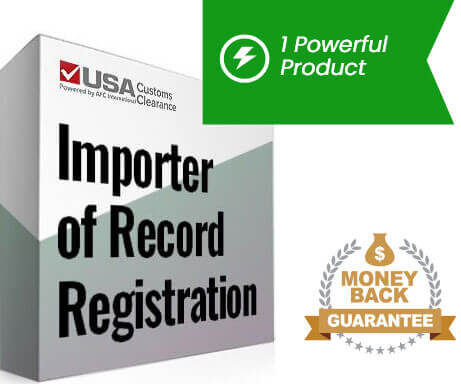
The various processes involved in importing goods to the US can leave even the savviest entrepreneurs scratching their heads. While there are several steps involved, they can be condensed down to five main points that will set you on the path toward running a successful import operation.
Key Takeaways
If you’re not sure how to become an importer in the US, these five steps will give you a solid foundation upon which to build your business.
Let’s start by assuming you already know what you want to import, you just don’t know how to go about getting your goods into the US.
Once you know what products you plan to import, your first step will be to register as an importer of record (IOR) in the United States. You’ll need to include information such as your name, contact information, business name, and how many entries you project to bring into the country over a one-year period.
If you find the amount of information this document asks for to be overwhelming, our team of customs brokers offers expedited IOR registration services that can spare you the headaches and uncertainty that sometimes come with filling out dense, government-mandated paperwork.
This process differs somewhat for foreign individuals or entities who wish to act as IORs in the US, but the basics remain the same.

Filing Is Time-Consuming.
Avoid Making Mistakes and Extra Costs.
We Submit Directly To The CBP.
Proper documentation is perhaps the most off-putting aspect of customs clearance for new importers. Some of these documents seem redundant, but ultimately serve different purposes in customs and logistics.
As an importer in the US, some documents with which you should become familiar are:
Speaking of the BoL, there are several versions of this invoice, but its ultimate purpose is to confer ownership of a shipment from the consignor (sender of the goods) to the consignee (the person or entity taking ownership of the shipment.)
Let’s look at two more common invoice types and contrast them with the BOL.
CBP requires importers to keep records of entry summaries for five years in case of post-transaction audits. If you work with a brokerage, they’ll usually maintain those records on your behalf.
Related: Documents for Import and Export
One of the advantages to being an importer in the United States is that there isn’t really such a thing as an import license: the IOR is less about licensure than it is about record keeping on CBP’s side.
Having said that, some commodities fall under the jurisdiction of CBP partner government agencies, or PGAs. Even if you’re totally new to importing, you’ve probably heard of some of them. Depending on the goods in question, these agencies may require you to apply for a special permit, or follow strict instructions about the parties from whom you source your goods.
In the graphic below, you’ll see some of the PGAs you might deal with as an importer. Some of the goods under each agency’s purview will be obvious just from the name, but you might be surprised at what the government considers a medicine or medical instrument.

Other PGAs govern goods from children’s toys to infectious biological agents, so take time to research the products you wish to import in case permits or special procedures are required on your behalf.
As a new commercial importer, you will need what’s called a continuous customs bond. This bond is used to guarantee that, should you underpay import fees (duties, tariffs, and port-related charges) on a given shipment, the surety that issued the bond will pay the balance to CBP on your behalf and bill you for the difference.
In this way, you can think of a customs bond as an agreement between three parties::
Continous bonds can be used at any port in the US over a 12-month period, at which point they can be renewed or canceled at the importer’s discretion.
The minimum amount of coverage you can purchase for a continuous customs bond is $50,000. As a general rule, you’ll want your bond to cover 10% of the total duties and tariffs you expect to pay over the course of a year, so $50k worth of coverage will be sufficient for a projection of $500,000 in duties and tariffs owed over 12 months.
If you project a higher amount, such as $750,000 (it’s always best to round up to avoid bond insufficiency), you’ll need $75,000 in coverage and so on as your projected customs fees increase.
Related: A Guide to U.S. Import Taxes: Duties, Tariffs, and Other Fees
I’m afraid I must confess that when I said there are five easy steps you can take to start importing, I lied. There’s really just one step: partner with a licensed US customs broker.
Brokers are licensed by CBP to handle the process of customs clearance for their clients. They can file paperwork on your behalf, ensure the proper Harmonized Tariff Schedule classification of your imported goods, and generally help you avoid the headaches that discourage so many would-be entrepreneurs from jumping into international trade.
To further simplify things, many customs brokers work for organizations that partner with or employ domestic shippers of their own. That means you can have international shipping, customs clearance, and domestic delivery handled under one roof by experts in their fields. Also, new importers will almost never be able to work directly with a surety in the first place, so a customs broker is a must for acquiring a customs bond under most circumstances.
Working with a licensed customs broker who partners with shipping companies means you can focus on marketing, refining your product offerings, and expanding your customer base. It may seem like a significant investment, but as easy as it is to start an import business, it’s just as easy for inexperienced importers to make mistakes that lead to crippling fines and censure from CBP.

Worried about the Strict Regulations? Ask Our Experts.
Our 45 Minute Licensed Expert Consulting Will Personally Guide You.
The licensed customs brokers at USA Customs Clearance have decades of experience helping business owners traverse the complex yet lucrative landscape of importing goods to the United States for resale. Our partnerships with domestic logistics providers give us the ability to perform customs brokerage, shipping, and even warehousing services, freeing you up to address more pressing business needs.
Our offerings include:
Call us today at (855) 912-0406 or fill out a contact form online and take the first step toward building your future in the world of importing.
 Copy URL to Clipboard
Copy URL to Clipboard
Add your first comment to this post